11 Things I Learned While Living in a Yurt
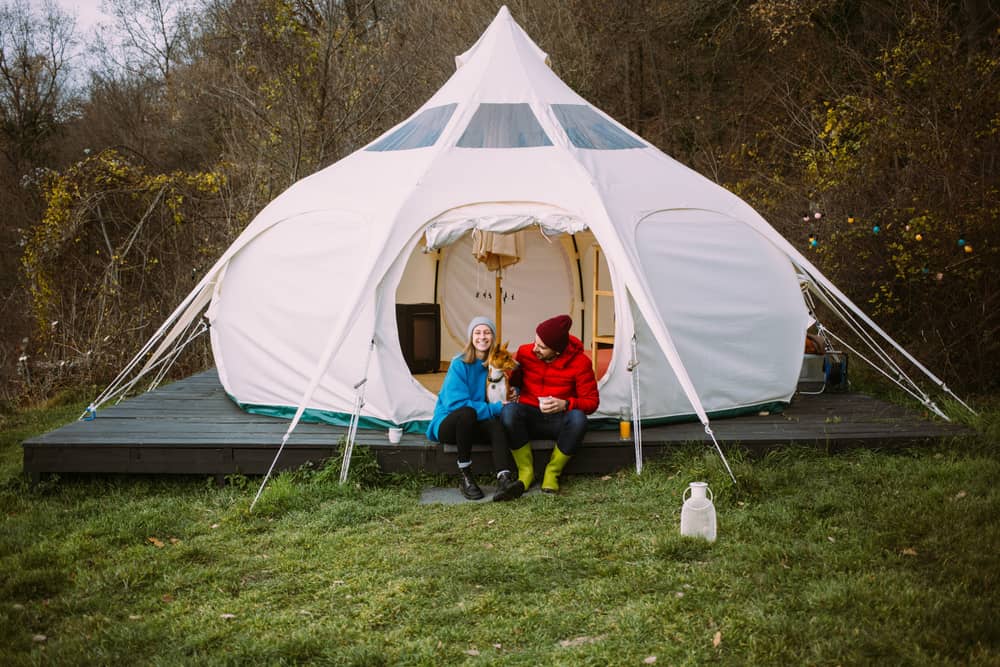
If you buy an item via links on this page, we may earn a commission. Our editorial content is not influenced by commissions. Read the full disclosure.
The wind is howling outside my tiny, New England yurt. It’s bitterly cold beyond my fragile, fabric walls. But indoors, my little family is living toasty warm as the candlelight flickers and the woodstove sends its warmth to all the non-corners of my little yurt roundhouse.
There’s not a lot of information on off-grid living or long-term yurt-life in general. If you’re interested in actually living in a yurt full time, you may be frustrated by the lack of actual information. I know I was!
In the first five years, we learned a lot of things the hard way. But don’t worry, you don’t have to. This guide can help.
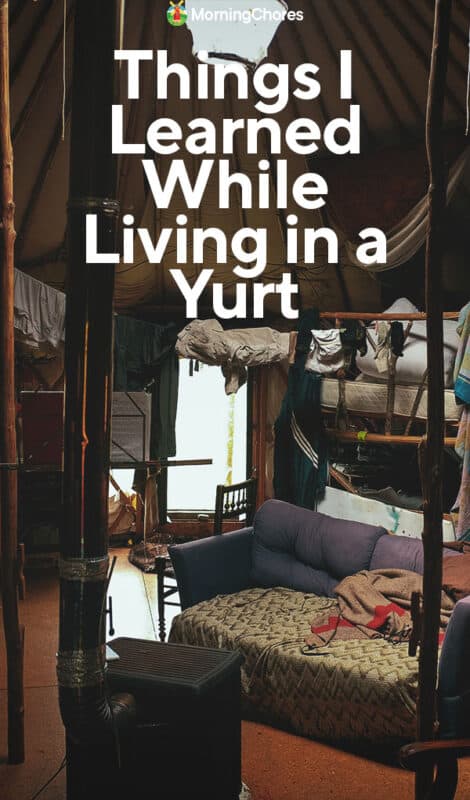
1. Temperature Regulation is an Art

Twelve years ago, facing my first winter in an off-grid yurt, I wasn’t sure what to expect. I grew up in the suburbs of southeast Michigan. Making the transition from Detroit girl to off-grid domesticity seemed like a huge jump into the unknown.
Fortunately, I was surrounded by supportive, patient people who helped me adjust to a whole new world.
Unless you’re on the grid running heaters and air conditioners non-stop, you’ll have to learn the “Art of Regulating Temperature.” Yurts don’t have corners to trap the cold. But when the walls are blocked by furniture or walls, it can be hard to heat those areas.
In the summer, even with all the windows open, modern yurts tend to absorb heat. Battery-powered fans, dome lifting kits, and insulation help a lot. But don’t’ expect to maintain a uniform temperature.
Put on a sweater, make some ice cream, or just enjoy the variety of weather that Mother Nature offers.
2. Lattice Walls Don’t Love Artwork
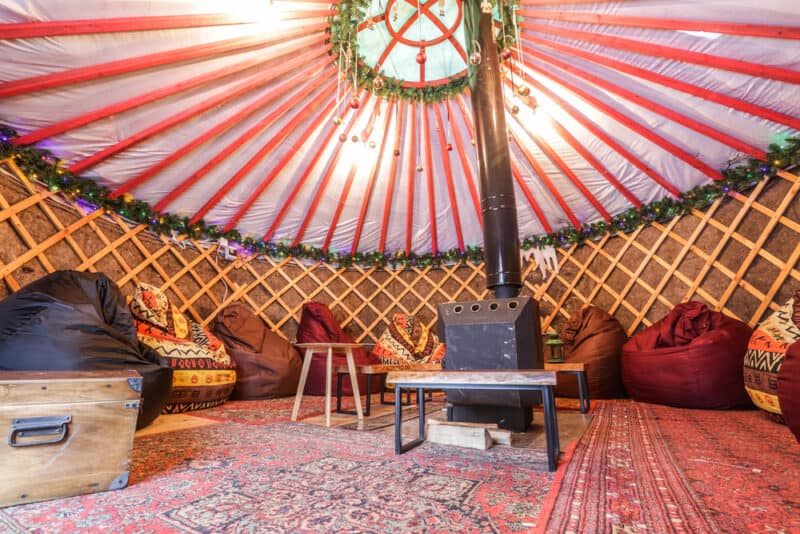
We hang a lot of art on our walls. Unfortunately, lattice walls don’t offer an easy, smooth surface on which to hang art. Large pieces are fine, but smaller paintings, wall sconces, and shelves tend to hang awkwardly on the walls. Openings in the lattice cause slumping or imbalances.
It can be a challenge to retrofit shelves and sconces so they’ll hang safely. We usually hang small paintings or fragile pieces off of larger shelves just to keep them stable. When a strong wind blows, or snow comes whooshing off the roof, unstable pieces will come crashing down.
Many yurt companies tell you not to put too many nails in your latticework. We haven’t had any problems with this, however. We’ve hung everything from full-length mirrors to plants on our walls and they’ve held up well. Just remember that the walls will shift with the wind, and small paintings may end up tucked between lattice and canvas.
3. Round Walls Are Design Challenges

Most furniture is designed for flat walls and right angles. When you put that furniture in a yurt, you end up with gaps between the furniture and the walls. Some people deal with this awkwardness by setting up a lot of interior walls.
It’s a great way to get a lot of smooth, right angles; but it can break up the space into too many tiny rooms. If you’re handy and have access to plenty of lumber, you can build furniture to fit your space better.
But most of the time, a lot of re-arranging is all it takes to find a layout that makes the most of the space without losing too much to those rounded walls.
4. Weather Can Get Loud

The modern yurt roof is usually just plasticized canvas coating with thin insulation. Unlike most houses, yurts don’t have much to dull the sound of rain on the roof. In a real downpour, we can’t hear the radio or each other.
Most rainstorms provide steady, soothing background noise. In the winter, the snow falls softly. But in a major storm when it whooshes down off the roof, the sound can wake everyone in the house.
It’s also easy to hear the calls of wild animals, the popping of trees as they freeze on cold nights, and all the other outdoor sounds that surround the yurt. Get used to the sounds of the world, if you want to try yurt living. It’s just a glorified tent, after all.
5. The Light Wakes Us Early
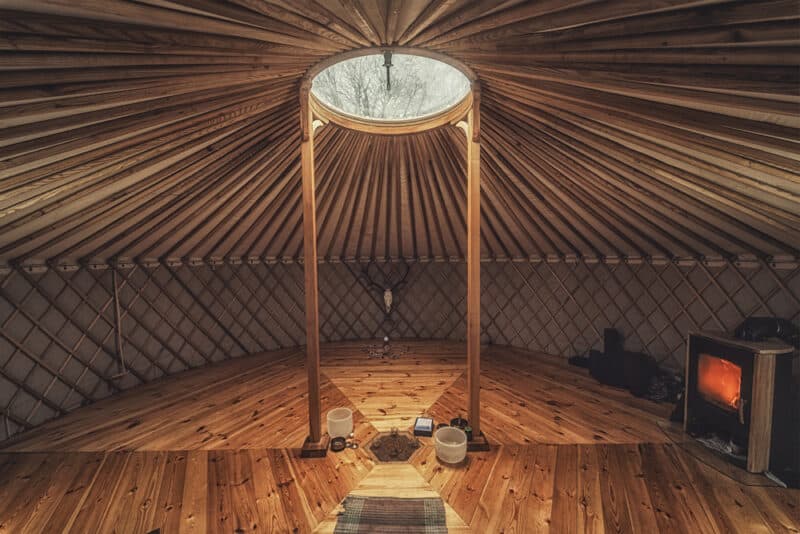
Big, clear domes are the defining feature of modern, American yurts. The dome is a delightful feature. We can see the stars at night and watch birds fly across the sky. But dawn comes early in the summer months.
It’s difficult to keep the bright sunlight from waking you at dawn when it’s shining in through a huge, round skylight. My children, who have lived their whole lives in the yurt, are early risers.
I have bed curtains, but nothing can completely keep out the light of the dome. It’s a helpful feature for homesteaders – no oversleeping for us! If you want to sleep late, your best bet is to build a little bedroom to keep the light out of your eyes.
Or invest in some good sleep masks!
6. You Don’t Need As Much Space As You Think
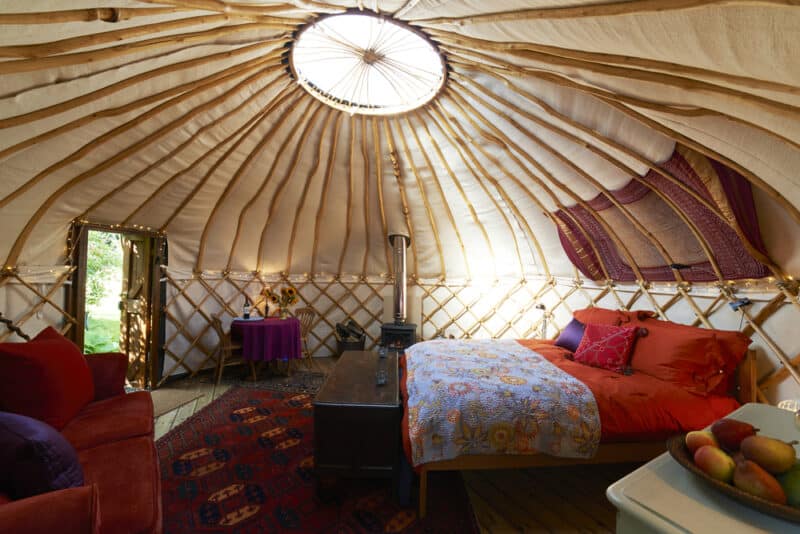
When we first moved into the yurt, it was supposed to be temporary. I really didn’t think I could handle living in 460 square feet of space for long. Twelve years, two kids, and two dogs later, I look around and feel pretty cozy.
Most people are used to having a lot of space. Whether you’ve got an apartment, a trailer, or a pretty, suburban home, it’s easy to look around and think that life under 800 sq feet is claustrophobic. But in reality, we can all adapt.
Small spaces can make for cozy evenings and close-knit families.
7. Luan isn’t Meant to Last
When you order a yurt kit from one of the American companies, they often recommend using thin plywood (luan) around the base of the yurt. It’s supposed to create a clean edge and help keep out pests. But luan doesn’t last. At least, it doesn’t last in many climates.
Ours didn’t even make it through the first winter. If you do choose to use luan, paint it with something tougher than the usual, outdoor paint, and be prepared to replace or repaint it regularly.
8. Pests Can Be a Problem
Yurts often have pest problems. Unless you’ve decided to make yours permanent, with lots of caulking and retrofitting, there will be a few places where mice and spiders can sneak in.
We’ve also had occasional garden snakes and songbirds. Fortunately, the snakes took care of the mice, and the dogs drove off the snakes. Yurts certainly keep you close to nature!
In general, pests are a minor problem. It’s easy to solve with a few mousetraps and little patience.
9. All Houses Need to Breathe
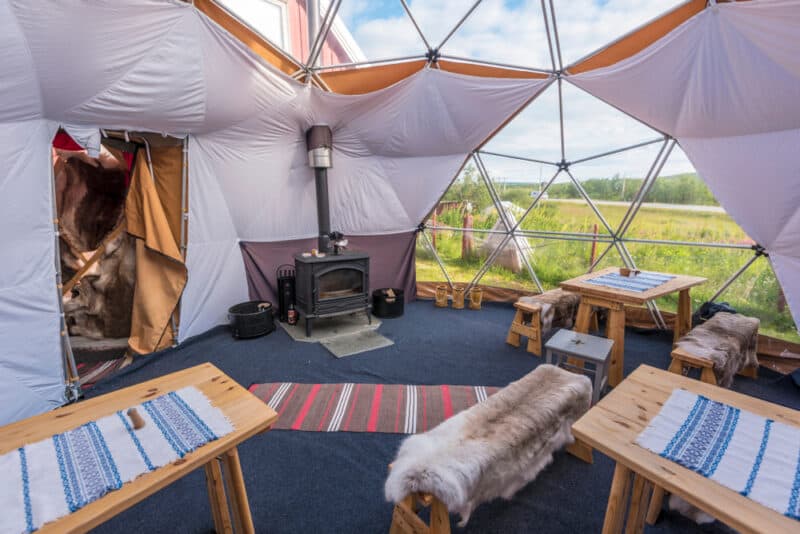
Traditional yurts breathe well. Their walls are of felted wool to keep in heat and absorb any excess moisture.
But modern yurts have plasticized canvas walls and roofs. Plasticized canvas doesn’t breathe well. In the winter, this can cause some serious moisture issues. Boiling water, bathing, and even breathing bring moisture into the air.
If there’s nowhere for it to go, that moisture condenses on the windows and walls of your yurt. If the weather outside is cold enough, and the wall is far enough from your heat source, the condensation freezes too.
Moisture is the biggest problem for modern yurts. Over the years, we’ve managed to work through a lot of moisture issues with better insulation, a heat-powered stove fan to spread the warmth, and an open layout.
Even with all the improvements though, moisture continues to be an issue throughout the winter and early spring.
10. Everything Old is New Again
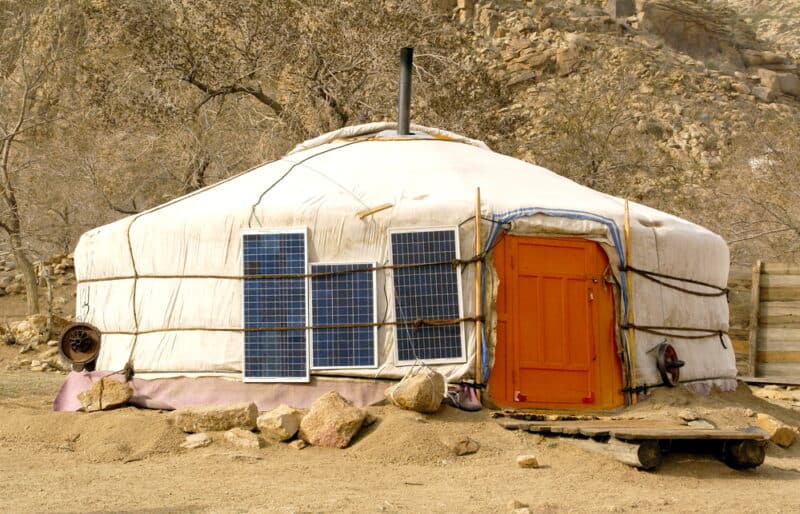
When we first started living in our off-grid yurt, we spent a lot of time at flea markets. Antique stores, flea markets, and thrift stores are ideal places to find helpful tools. We didn’t have solar power, so we gathered hand-crank coffee mills, oil lamps, and wood cookstoves instead.
It’s been a joy to rediscover some of the beautiful tools of the past. We’re lucky that old tools are built to last. We’ve also learned that Amish supply shops are a great way to find new, but non-electric items like hand-crank blenders and propane or solar appliances.
Because we didn’t have much expendable income when we first settled in, solar wasn’t a part of our homestead. We use some battery-powered objects and a hand-powered record player. But even now, most of our appliances are re-used antiques.
11. There’s No Place Like Home
I’ve learned a lot about off-grid yurt living in the past 12 years. I know about keeping the yurt cool in the summer and warm in the winter. I’ve learned about composting toilets and outdoor bathing. I know how to care for my livestock and handwash my clothes.
But the best lesson is that a few extra chores in the morning and evening are nothing compared to the joy of watching the moon through the dome. Yurt living has its challenges, but it’s worth every one.
In the next two years, we’ll be taking down the yurt for a deep cleaning and repair project. Yurt-skins (the plasticized canvas) have a life expectancy of about 10-15 years. Our looks like it’s in good shape, but we’ll be making sure. Then, we’ll refresh the platform, set the yurt back up, and settle in again.
What was once a “5-year plan” has become a home. I wouldn’t change it for the world.
